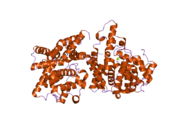PDE10A
| View/Edit Human | View/Edit Mouse |
cAMP and cAMP-inhibited cGMP 3',5'-cyclic phosphodiesterase 10A is an enzyme that in humans is encoded by the PDE10A gene.[4][5]
Various cellular responses are regulated by the second messengers cAMP and cGMP. Phosphodiesterases, such as PDE10A, eliminate cAMP- and cGMP-mediated intracellular signaling by hydrolyzing the cyclic nucleotide to the corresponding nucleoside 5-prime monophosphate.[5][6]
Inhibitors
_in_tube_model.png)
3d model of compound #96 (Malamas, 2011)[7]
- Compound 96: IC50 = 700 pM, high selectivity against all other members of the PDE family[7]
- Papaverine[8]
- PF-2545920[9]
- TAK-063: IC50 = 300 pM[10]
- AMG 579[11]
Research
Preliminary evidence indicates a possible link between PDE10A expression and obesity in mice and humans.[12]
References
- ↑ "Diseases that are genetically associated with PDE10A view/edit references on wikidata".
- ↑ "Human PubMed Reference:".
- ↑ "Mouse PubMed Reference:".
- ↑ Fujishige K, Kotera J, Michibata H, Yuasa K, Takebayashi S, Okumura K, Omori K (Jul 1999). "Cloning and characterization of a novel human phosphodiesterase that hydrolyzes both cAMP and cGMP (PDE10A)". J Biol Chem. 274 (26): 18438–45. doi:10.1074/jbc.274.26.18438. PMID 10373451.
- 1 2 "Entrez Gene: PDE10A phosphodiesterase 10A".
- ↑ Fujishige K, Kotera J, Yuasa K, Omori K (October 2000). "The human phosphodiesterase PDE10A gene genomic organization and evolutionary relatedness with other PDEs containing GAF domains". Eur. J. Biochem. 267 (19): 5943–51. doi:10.1046/j.1432-1327.2000.01661.x. PMID 10998054.
- 1 2 Malamas, MS; et al. (2011). "Highly potent, selective, and orally active phosphodiesterase 10A inhibitors". J. Med. Chem. 54 (21): 7621–38. doi:10.1021/jm2009138. PMID 21988093.
- ↑ Siuciak JA, Chapin DS, Harms JF, et al. (August 2006). "Inhibition of the striatum-enriched phosphodiesterase PDE10A: a novel approach to the treatment of psychosis". Neuropharmacology. 51 (2): 386–96. doi:10.1016/j.neuropharm.2006.04.013. PMID 16780899.
- ↑ Verhoest PR, Chapin DS, Corman M, et al. (August 2009). "Discovery of a novel class of phosphodiesterase 10A inhibitors and identification of clinical candidate 2-[4-(1-methyl-4-pyridin-4-yl-1H-pyrazol-3-yl)-phenoxymethyl]-quinoline (PF-2545920) for the treatment of schizophrenia". J. Med. Chem. 52 (16): 5188–96. doi:10.1021/jm900521k. PMID 19630403.
- ↑ Kunitomo J, Yoshikawa M, Fushimi M, et al. (2014). "Discovery of 1-[2-Fluoro-4-(1H-pyrazol-1-yl)phenyl]-5-methoxy-3-(1-phenyl-1H-pyrazol-5-yl)pyridazin-4(1H)-one (TAK-063), a Highly Potent, Selective, and Orally Active Phosphodiesterase 10A (PDE10A) Inhibitor". J. Med. Chem. 57 (22): 9627–43. doi:10.1021/jm5013648. PMID 25384088.
- ↑ Hu; et al. (2014). "Discovery of Clinical Candidate 1-(4-(3-(4-(1Hbenzo[d]imidazole-2-carbonyl)phenoxy)pyrazin-2-yl)piperidin-1-yl)ethanone (AMG 579), a Potent, Selective, and Efficacious Inhibitor of Phosphodiesterase 10A (PDE10A)".". J Med Chem.
- ↑ Hankir, Mohammed K; et al. (2016). "A novel thermoregulatory role for PDE10A in mouse and human adipocytes.". EMBO Molecular Medicine.
Further reading
- Loughney K, Snyder PB, Uher L, et al. (1999). "Isolation and characterization of PDE10A, a novel human 3', 5'-cyclic nucleotide phosphodiesterase.". Gene. 234 (1): 109–17. doi:10.1016/S0378-1119(99)00171-7. PMID 10393245.
- Kotera J, Fujishige K, Yuasa K, Omori K (1999). "Characterization and phosphorylation of PDE10A2, a novel alternative splice variant of human phosphodiesterase that hydrolyzes cAMP and cGMP.". Biochem. Biophys. Res. Commun. 261 (3): 551–7. doi:10.1006/bbrc.1999.1013. PMID 10441464.
- Zauli G, Milani D, Mirandola P, et al. (2001). "HIV-1 Tat protein down-regulates CREB transcription factor expression in PC12 neuronal cells through a phosphatidylinositol 3-kinase/AKT/cyclic nucleoside phosphodiesterase pathway.". FASEB J. 15 (2): 483–91. doi:10.1096/fj.00-0354com. PMID 11156964.
- Frame M, Wan KF, Tate R, et al. (2001). "The gamma subunit of the rod photoreceptor cGMP phosphodiesterase can modulate the proteolysis of two cGMP binding cGMP-specific phosphodiesterases (PDE6 and PDE5) by caspase-3.". Cell. Signal. 13 (10): 735–41. doi:10.1016/S0898-6568(01)00193-0. PMID 11602184.
- Strausberg RL, Feingold EA, Grouse LH, et al. (2003). "Generation and initial analysis of more than 15,000 full-length human and mouse cDNA sequences.". Proc. Natl. Acad. Sci. U.S.A. 99 (26): 16899–903. doi:10.1073/pnas.242603899. PMC 139241
 . PMID 12477932.
. PMID 12477932. - Mungall AJ, Palmer SA, Sims SK, et al. (2003). "The DNA sequence and analysis of human chromosome 6.". Nature. 425 (6960): 805–11. doi:10.1038/nature02055. PMID 14574404.
- Ota T, Suzuki Y, Nishikawa T, et al. (2004). "Complete sequencing and characterization of 21,243 full-length human cDNAs.". Nat. Genet. 36 (1): 40–5. doi:10.1038/ng1285. PMID 14702039.
- Gerhard DS, Wagner L, Feingold EA, et al. (2004). "The status, quality, and expansion of the NIH full-length cDNA project: the Mammalian Gene Collection (MGC).". Genome Res. 14 (10B): 2121–7. doi:10.1101/gr.2596504. PMC 528928
 . PMID 15489334.
. PMID 15489334. - Gross-Langenhoff M, Hofbauer K, Weber J, et al. (2006). "cAMP is a ligand for the tandem GAF domain of human phosphodiesterase 10 and cGMP for the tandem GAF domain of phosphodiesterase 11.". J. Biol. Chem. 281 (5): 2841–6. doi:10.1074/jbc.M511468200. PMID 16330539.
- Chappie TA, Helal CJ, Hou X (2012). "Current Landscape of Phosphodiesterase 10A (PDE10A) Inhibition.". J. Med. Chem. 55 (17): 7299–7331. doi:10.1021/jm3004976. PMID 22834877.
This article incorporates text from the United States National Library of Medicine, which is in the public domain.
This article is issued from Wikipedia - version of the 6/17/2016. The text is available under the Creative Commons Attribution/Share Alike but additional terms may apply for the media files.














